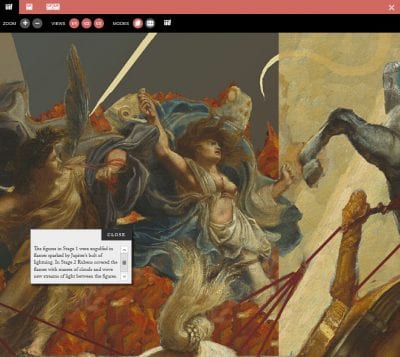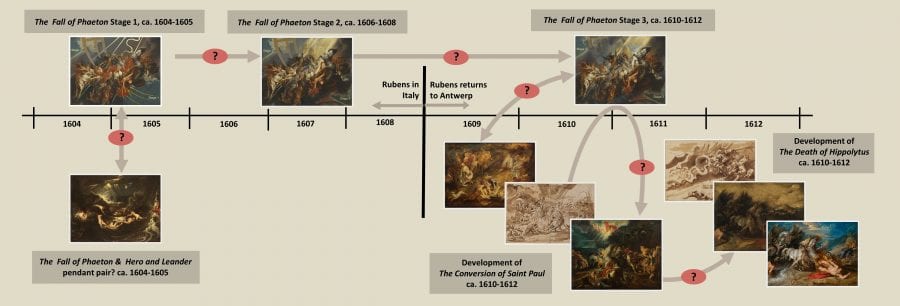This section gives direct access to the image tools that are also embedded in the illustrations within the main article in this Issue,”Rubens’ Invention and Evolution: Material Evidence in The Fall of Phaeton.” Using the IIIF multi-mode viewer and the side-by-side viewer, the reader can undertake independent exploration of all the technical documents available for The Fall of Phaeton.
The Multi-mode Viewer
Using the IIIF multi-mode viewer, the surface of the painting itself can be compared to the technical images, and each can be studied at increasing magnification up to a microscopic level, in “layer mode” or “side-by-side mode”. Using this viewer, it is also possible to compare the brushstrokes visible on the painting’s surface to the layers of the painting as seen in paint cross sections.



The Side-by-Side Viewer

Using the side-by-side viewer, the reader can juxtapose any two works of art illustrated in the article, zooming in to make detailed comparisons. Click on any of the images in the slide show below to access this viewer. Use the icons in the toolbar to toggle between the single image viewer and the side-by-side viewer. Use the drop-down menu to compare that image to any other work of art illustrated in the article.
Interactive Timeline
This graphic lays out the relationship between The Fall of Phaeton and several other works by Rubens between 1604 and 1612. Click to open the image viewer, then hover over marked hot spots for annotations summarizing some of the material evidence discussed in “Rubens’ Invention and Evolution: Material Evidence in The Fall of Phaeton.”

Interpreting Technical Documents

The Paint Surface
By studying the surface of the painting at high magnification, we can see Rubens at work: close examination reveals his individual brushstrokes. We often can deduce the order in which he painted individual details: looking to see whether brushstrokes lie over earlier paint that had already dried, or whether they blend wet-into-wet with the underlying brushstrokes. In Stage 3, when Rubens added the white horse beside the gray horse of Stage 1, he brushed creamy white paint around the lower leg of the gray horse and let a few wisps of white paint overlap the dry gray paint. But at the top of the gray upper leg, his white and gray paint strokes blur together: evidence that when he added the white horse in Stage 3 he also repainted that gray leg.
X-radiography

An x-radiograph can reveal painted details hidden below the painting’s surface. Because x-rays pass completely through the painting, this image records all layers of the painting, with dense materials blocking the x-rays more than lighter-weight materials. Pigments such as white lead and vermilion (with the highest atomic weights) appear light-colored, while pigments such as ochre or charcoal black (lowest atomic weights) seem dark. In the same way, the bars of the wooden stretcher appear gray, while metal nails (which hold the canvas to the stretcher) appear white. In the lower right quadrant the x-radiograph of The Fall of Phaeton shows features that no longer are visible in the painting: bright jets of light and clouds below Phaeton, and the foot of a Hora Rubens painted out.
Infrared Reflectography
In an infrared reflectogram (IRR), black pigments absorb IR light (appearing black) and other pigments reflect it (appearing white), while still other pigments are transparent in IR light. Unlike IRR images of Early Netherlandish paintings, which typically show a clear image of black underdrawing on a white ground, IRR images of seventeenth century paintings on dark grounds (like The Fall of Phaeton and Hero and Leander) rarely show an obvious underdrawing. Instead these images give information on variations in the paints the artist used. In standard infrared reflectograms (seen here in the IRR image of Hero and Leander) these variations appear as a range of gray tones, corresponding to the varying behavior of the paints in IR light.
A newer technique, “false-color” infrared reflectography (see here in the IR image of The Fall of Phaeton) assigns colors to three different IRR images captured at three different wavelengths within the IR region. Because materials behave differently in different parts of the IR spectrum, this “false-color” IRR image creates faint color variations that highlight subtle material differences. For example, the paint Rubens used for the white horse he added in Stage 3 of The Fall of Phaeton has a bluish tone in this image; a similar bluish patch on the neck of the gray horse suggests that Rubens also touched up the horse, using the same white paint.
Paint Analysis

The pigments Rubens used to color his paints in The Fall of Phaeton were identified through microscopic paint analysis using a light microscopy and scanning electron microscopy with energy dispersive spectroscopy (SEM-EDS). Microscopic paint samples are removed only from areas of existing damage, using micro-scale eye-surgery scalpels. The scale bars appearing in the sample images are measured in micrometers (µ): one micrometer equals one thousandth of a millimeter. With paint cross-section samples, light microscopy reveals the sequence of paint layers corresponding to the various colors Rubens used for the three different stages of the composition. SEM-EDS, which shows the distribution of the chemical elements in those layers, helps to identify the specific pigments used.
Pigments
In The Fall of Phaeton, Rubens’s pigments included:
- lead white: http://cameo.mfa.org/wiki/Lead_white
- lead-tin yellow: http://cameo.mfa.org/wiki/Lead-tin_yellow
- vermilion: http://cameo.mfa.org/wiki/Vermilion
- red lake: http://cameo.mfa.org/wiki/Lake
- indigo: http://cameo.mfa.org/wiki/Indigo
- natural ultramarine: http://cameo.mfa.org/wiki/Ultramarine_blue,_natural
- yellow ochre: http://cameo.mfa.org/wiki/Yellow_ocher
- red ochre: http://cameo.mfa.org/wiki/Red_ocher
- charcoal black: http://cameo.mfa.org/wiki/Charcoal_black
- bone black: http://cameo.mfa.org/wiki/Bone_black
source of references – CAMEO – The Conservation and Art Materials Encyclopedia Online – an electronic database that compiles, defines, and disseminates technical information on the distinct collection of terms, materials, and techniques used in the fields of art conservation and historic preservation. Site: http://cameo.mfa.org/














































